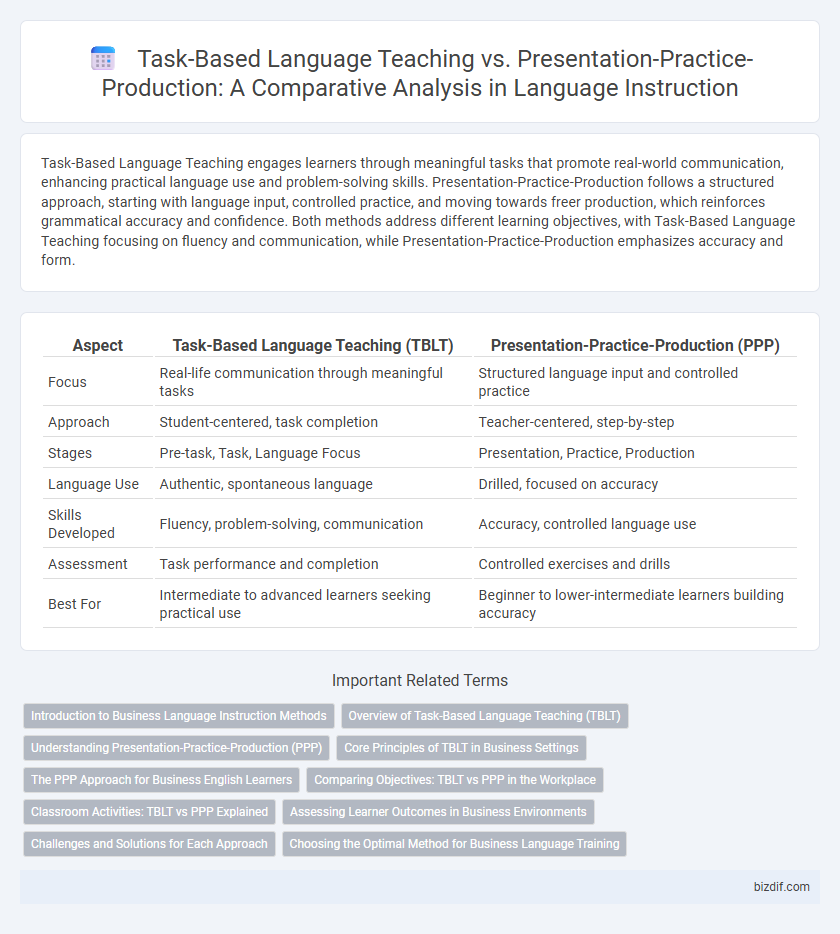Task-Based Language Teaching engages learners through meaningful tasks that promote real-world communication, enhancing practical language use and problem-solving skills. Presentation-Practice-Production follows a structured approach, starting with language input, controlled practice, and moving towards freer production, which reinforces grammatical accuracy and confidence. Both methods address different learning objectives, with Task-Based Language Teaching focusing on fluency and communication, while Presentation-Practice-Production emphasizes accuracy and form.
Table of Comparison
| Aspect | Task-Based Language Teaching (TBLT) | Presentation-Practice-Production (PPP) |
|---|---|---|
| Focus | Real-life communication through meaningful tasks | Structured language input and controlled practice |
| Approach | Student-centered, task completion | Teacher-centered, step-by-step |
| Stages | Pre-task, Task, Language Focus | Presentation, Practice, Production |
| Language Use | Authentic, spontaneous language | Drilled, focused on accuracy |
| Skills Developed | Fluency, problem-solving, communication | Accuracy, controlled language use |
| Assessment | Task performance and completion | Controlled exercises and drills |
| Best For | Intermediate to advanced learners seeking practical use | Beginner to lower-intermediate learners building accuracy |
Introduction to Business Language Instruction Methods
Task-Based Language Teaching (TBLT) emphasizes real-world business tasks to develop practical communication skills, enhancing learner engagement and contextual understanding. Presentation-Practice-Production (PPP) follows a structured approach, introducing business language through clear presentations, controlled practice, and independent production to ensure accuracy. Both methods offer effective frameworks, but TBLT prioritizes authentic language use while PPP focuses on systematic skill acquisition for business language learners.
Overview of Task-Based Language Teaching (TBLT)
Task-Based Language Teaching (TBLT) centers on using authentic tasks as the core unit of planning and instruction, promoting meaningful communication and practical language use. It emphasizes learner engagement through real-world activities, fostering fluency and problem-solving skills rather than isolated language drills. TBLT contrasts with Presentation-Practice-Production (PPP) by prioritizing task completion over explicit language presentation and controlled practice stages.
Understanding Presentation-Practice-Production (PPP)
Presentation-Practice-Production (PPP) is a widely used language instruction framework that emphasizes a clear, structured approach to teaching new language items by first introducing the target language in a focused presentation phase. The practice phase provides controlled activities to reinforce accuracy, while the production phase encourages learners to use the language more freely and creatively to build fluency. This method is especially effective for beginners as it helps internalize grammar and vocabulary before applying them in communicative contexts.
Core Principles of TBLT in Business Settings
Task-Based Language Teaching (TBLT) centers on using authentic business tasks to drive language acquisition, emphasizing real-world communication over isolated grammar drills. Core principles include learner-centered activities, meaningful interaction, and task completion that mirrors workplace scenarios such as meetings, negotiations, and presentations. This approach enhances practical language proficiency and problem-solving skills essential for effective business communication.
The PPP Approach for Business English Learners
The Presentation-Practice-Production (PPP) approach in Business English instruction emphasizes a structured progression from introducing new language concepts to controlled practice and finally to free production, which helps learners build confidence in professional communication. Business English learners benefit from PPP's clear framework that targets specific language functions like negotiations, email writing, and presentations, ensuring practical relevance and immediate application. The approach supports incremental skill development, making it easier for learners to grasp complex business terminology and develop fluency in workplace scenarios.
Comparing Objectives: TBLT vs PPP in the Workplace
Task-Based Language Teaching (TBLT) emphasizes authentic communication and practical problem-solving skills, aiming to prepare learners for real-world workplace interactions. Presentation-Practice-Production (PPP) focuses on systematic language input, controlled practice, and guided production, targeting accuracy and grammatical competence. In workplace language instruction, TBLT prioritizes task completion and fluency, whereas PPP centers on structural mastery and error minimization.
Classroom Activities: TBLT vs PPP Explained
Task-Based Language Teaching (TBLT) prioritizes authentic communication through real-world tasks, encouraging learners to engage in problem-solving, collaboration, and meaningful interaction. Presentation-Practice-Production (PPP) follows a structured approach where teachers first present language concepts, then lead controlled practice, and finally guide students to produce language independently. Classroom activities in TBLT involve open-ended projects, role-plays, and task completion, while PPP emphasizes drills, repetition, and guided exercises designed to reinforce specific language points.
Assessing Learner Outcomes in Business Environments
Task-Based Language Teaching (TBLT) emphasizes authentic communication and problem-solving, resulting in improved practical language skills for business interactions and real-world scenarios. Presentation-Practice-Production (PPP) focuses on structured language input and controlled practice, which may limit learners' ability to adapt language use flexibly in dynamic business contexts. Assessing learner outcomes in business environments reveals that TBLT often leads to higher proficiency in spontaneous negotiation, email writing, and meeting participation compared to the more formulaic results typical of PPP.
Challenges and Solutions for Each Approach
Task-Based Language Teaching (TBLT) challenges include unpredictable learner output and difficulty in syllabus design, requiring adaptive materials and continuous teacher training to maximize communicative competence. Presentation-Practice-Production (PPP) faces limitations in fostering spontaneous language use and engagement, solved by integrating authentic communicative tasks and promoting learner interaction to enhance retention. Effective language instruction balances TBLT's learner-centered innovation with PPP's structured reinforcement to address diverse learner needs and optimize language acquisition outcomes.
Choosing the Optimal Method for Business Language Training
Task-Based Language Teaching (TBLT) emphasizes real-world business scenarios, enhancing communicative competence through practical tasks like negotiations and presentations, which directly align with workplace demands. Presentation-Practice-Production (PPP) offers structured learning stages, beneficial for mastering specific business vocabulary and grammar, but may lack contextual immersion. Selecting the optimal method depends on training objectives: TBLT suits interactive skill development in dynamic business settings, while PPP is effective for reinforcing foundational language elements in formal corporate environments.
Task-Based Language Teaching vs Presentation-Practice-Production Infographic

 bizdif.com
bizdif.com